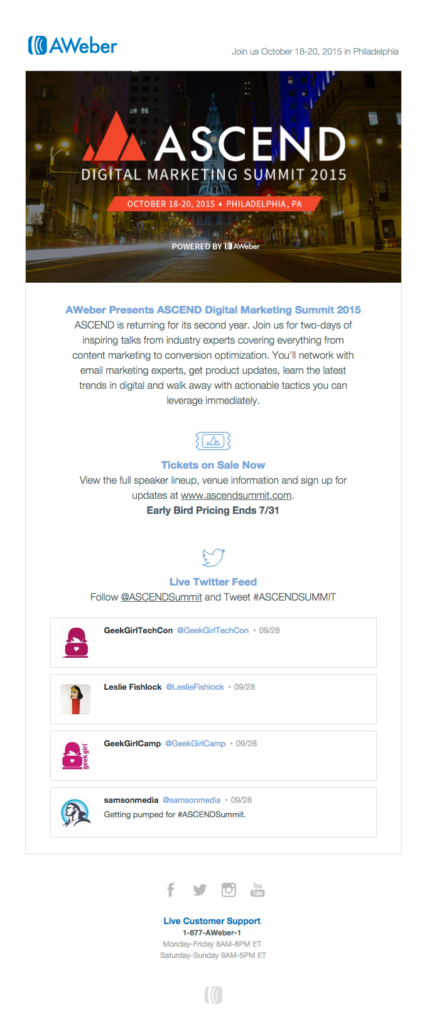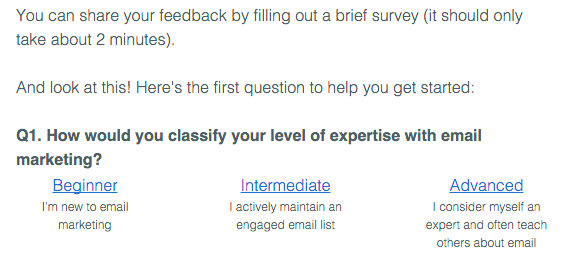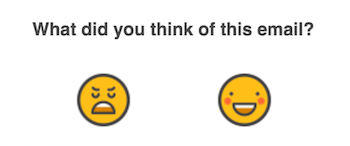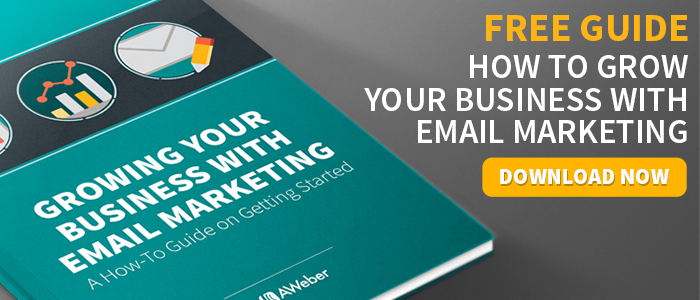4 Ways Interactive Content Can Up Your Email Marketing Game
By Olivia Dello Buono April 27, 2016
It’s not a new concept, but it’s getting a lot of hype lately amongst the email community. It’s even been coined the “next big thing” in email.
We’re talking about interactive content.
Interactive content brings a fresh approach to email, a channel often looked to as static and dated. (We know that’s not true.) Personalization, animation, segmentation; the possibilities are endless. And it’s not just about creating really, really, ridiculously good-looking emails.
Interactive email can:
- Make your content more compelling
- Improve your engagement
- Delight your subscribers
So why aren’t more brands doing it?
The TL;DR version: It’s difficult. Creating brilliant, engaging emails isn’t for the faint of heart – but it can be done. Here are four examples of how we’ve used interactive content in our own emails (and how you can recreate them for yourself):
1. Dynamic Twitter Feed
The email design community was abuzz when Litmus launched a live twitter feed inside one of their emails for The Email Design Conference. Anyone could engage with the feed by simply tweeting with the #TEDC15 hashtag. New tweets would show up in the feed in realtime.
For last year’s ASCEND Summit, we decided to test out the idea in one of our pre-conference emails:

The results? Pretty cool, if we do say so ourselves. (Really Good Emails agrees!)
Kelsey P., the design lead on the project, explains: “We had never really done an interactive email. With the upcoming conference, we wanted to give our audience something to engage with, something to get them excited about. Adding the live twitter feed not only pulled in that social proof, but gave the email a personal touch and got people talking.”
Skill Level: Advanced
Want to try it out for yourself? Head over to Litmus for the full breakdown of instructions. We won’t sugarcoat this one: it’s hard. But the results? 100 percent worth it.
2. Email Sentiment Widget
Gauge subscribe reactions right from the inbox by adding an email sentiment widget to your next campaign, like this one:
“We were aiming to find a way to let our subscribers tell us how they feel about the emails we send them with the least possible friction,” says Chris V., Creative Director at AWeber. “The simple, two option sentiment widget not only gives them the ability to register feedback on an email without feeling like they have to commit to filling out a traditional survey, it’s also pretty darn delightful. It was such a success that we decided to build and share a tool for anyone who loves email to make one of these widgets on their own.”
Skill Level: Intermediate
We’ve done the hard part for you! Get the code (and instructions to add it to your emails) here.
3. Email Survey
Ok, so technically you can’t embed a survey into your emails. (At least, not yet!) But you can use this hack from SurveyGizmo to allow your subscribers to answer the first question of your survey within a message. Here’s an example:

As Chris explains, “We survey our subscribers fairly regularly and are trying to find ways to improve both the quality of the the responses we get and the experience for our readers. We decided to include our first question in our survey emails for two reasons: First, it removes an unnecessary step to get to the survey, thus saving some valuable seconds and attention for our subscribers. Second, we were hoping to increase completion rates by having respondents who clicked an initial answer feel like they were already invested in the survey. Our initial experiments have worked out well enough for us to model all of the surveys in our campaigns to use this pattern.”
Skill Level: Intermediate
Have some basic HTML knowledge? Check out SurveyGizmo for the instructions. (Note: You’ll need a SurveyGizmo account to use this feature.)
4. GIFs
Using animated GIFs in your emails is a great way to add an element of delight to your emails. But they can be used for so much more than a few laughs.
GIFs can also help illustrate a product or feature. Take a look at this example from one of our recent Curate email campaigns:

While the GIF doesn’t tell the whole story, it gives subscribers a little more context into what the app can do. You can even use a series of GIFs in place of lengthy copy to build out your idea. We love anything that helps turn a complex concept into something that’s easier to digest.
Skill Level: Beginner to Intermediate
Even if you’re not a designer, you can still use GIFs in your emails. Check out Giphy for a large selection of animated GIFs, or create your own using an app like GIFMaker.me.
Want more email inspiration?
From welcome messages and re-engagement campaigns to great uses of GIFs in email, we’ve got a whole Pinterest board full of beautiful email campaigns.
How are you using interactive content in your emails? We want to know! Leave us a comment or tweet us @AWeber and tell us how – or better yet, show us!


playview apk for android
4/28/2016 5:23 amNice post on Email marketing tips. very useful for freshers
Gregg Blanchard
4/28/2016 3:27 pmLove ideas 2-4, Olivia.
Have seen first hand the value of getting email-specific feedback (though it closely correlates to open/click rates so it can be redundant) as well as one-click, in-email surveys. And I’ve dug through numbers that show GIFs do, indeed, keep attention and increase open rates when used well.
The Twitter timeline, on the other hand, I’m afraid I don’t follow you on. I know a lot of people are excited about that functionality, but I’m having trouble seeing the value behind the shiny exterior.
Olivia Dello Buono
4/28/2016 3:33 pmThanks for reading, Gregg!
I’m happy to see that you’ve seen success with using in-email surveys and GIFs!
As far as your concern with using a Twitter feed, you’re right. It may not be for everyone. The best use cases I’ve seen are the ones that use it as a means of social proof. I think it’s best for events (as we used it here), as it keeps the momentum going!
Chris "?" Vasquez
4/28/2016 9:59 pmGregg, it sounds like you’re doing some pretty rad stuff in your email. I’d love to swap email experiment stories with you sometime. We’re always looking to learn new tricks and over here.
We saw a really interesting use case for the sentiment widget recently where we tested a control email that included a generic CTA + a static image of our customer solutions team vs a variation that was exactly the same except the image was replaced with an animated gif of the team. The version with the gif had significantly higher click through (which I had hypothesized), but it was completely driven by more people clicking on the happy face (which I hadn’t expected). In fact, the CTR on the call to action button was slightly (although not significantly) lower on the gif version.
Scott Alan Reed
4/30/2016 2:00 pmThere was a time when ANY active content in e-mail set off bells, whistles and red flags. It would seem to me that animation, GIFs, and live Twitter feeds would all be detected as active content and trigger warnings on the receivers end to be cautious about opening this e-mail. Did I miss a paradigm shift?
The Kapil Sharma Show
5/4/2016 6:35 amThis actually works. And Twitter Feed strategy is awesome. I recently applied it to my website and it paid me back.
Martin Codina
5/7/2016 11:55 amI share Scott’s concern
Have any studies been done to determine the deliverability of emails which include this type of content?
Thanks
Brandon Lewin
5/16/2016 10:28 amGreat ideas, Olivia! I love getting emails with gif’s. It makes my day that much better.
The other ideas were fantastic, although some of the skill levels require coding knowledge.
Do you have any idea how the response rate compares between a nicely designed website with some interactive content added to a plain text email with a link or call to action in it?
I was wondering if you tested it. I still find a plain text emails with a gif or image does a lot better than a “designed” email.
Olivia Dello Buono
5/16/2016 4:08 pmHi Brandon! Glad to see you love GIFs as much as we do.
To answer your question, we have done tests in the past to see whether HTML emails get a higher response rate than plain text. In this instance, subscribers responded more to the HMTL versions. You can see what we tested in the blog post.
I will point out that there’s really no right or wrong answer. Testing is the way to go! If you do choose to go the HTML route, be sure to optimize your emails. Leaning towards plain text? We love this post by Litmus that covers all the basics.
Leonardo LaVito @ LargerList.com
5/17/2016 12:21 amGreat ideas! 🙂
I especially like the use of the Email Sentiment Widgets, and GIFs.
From what I’ve seen, they tend to get a lot of interaction going. Especially when sending out interesting emails.
The Email Sentiment Widgets can also be crafted to double as “call to action” buttons when cleverly used. So they are really fun to play with.